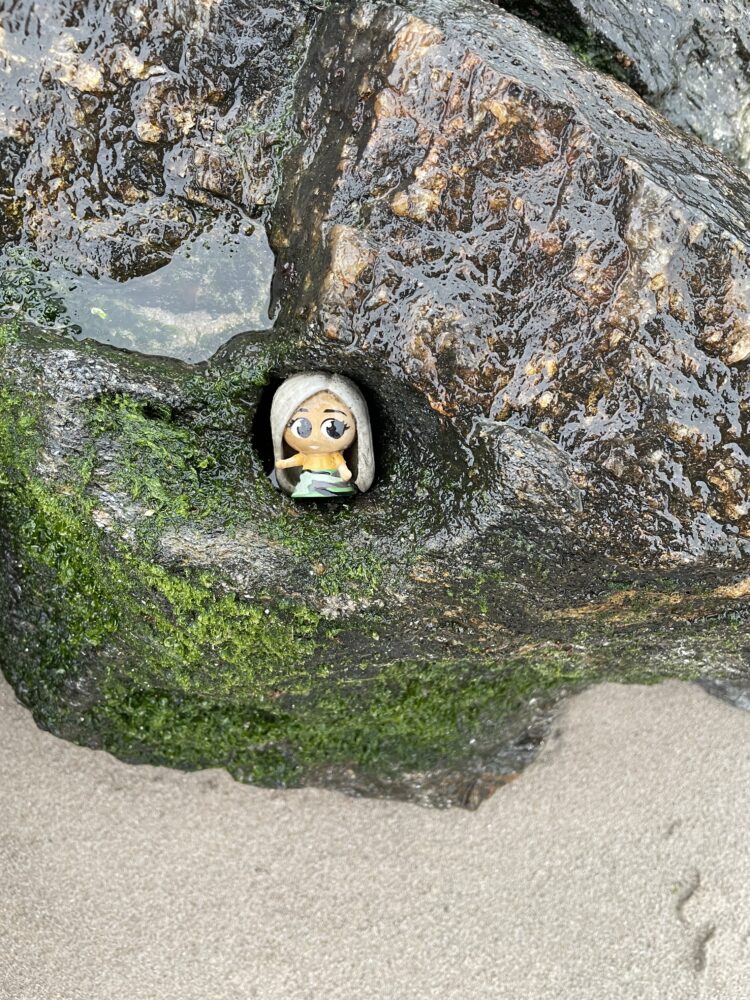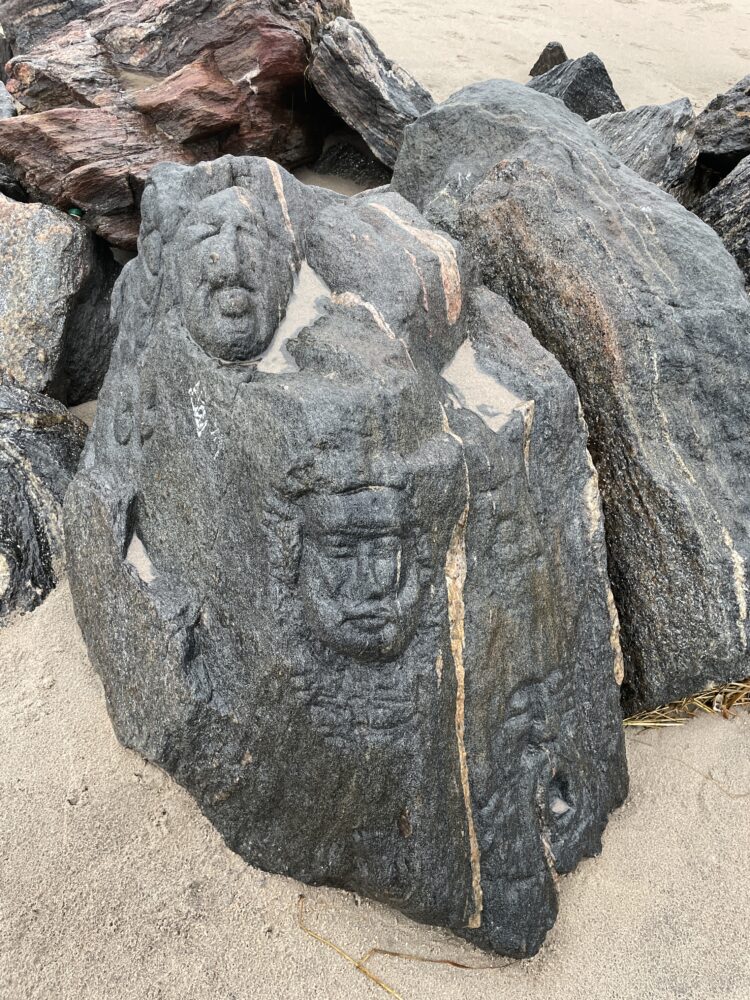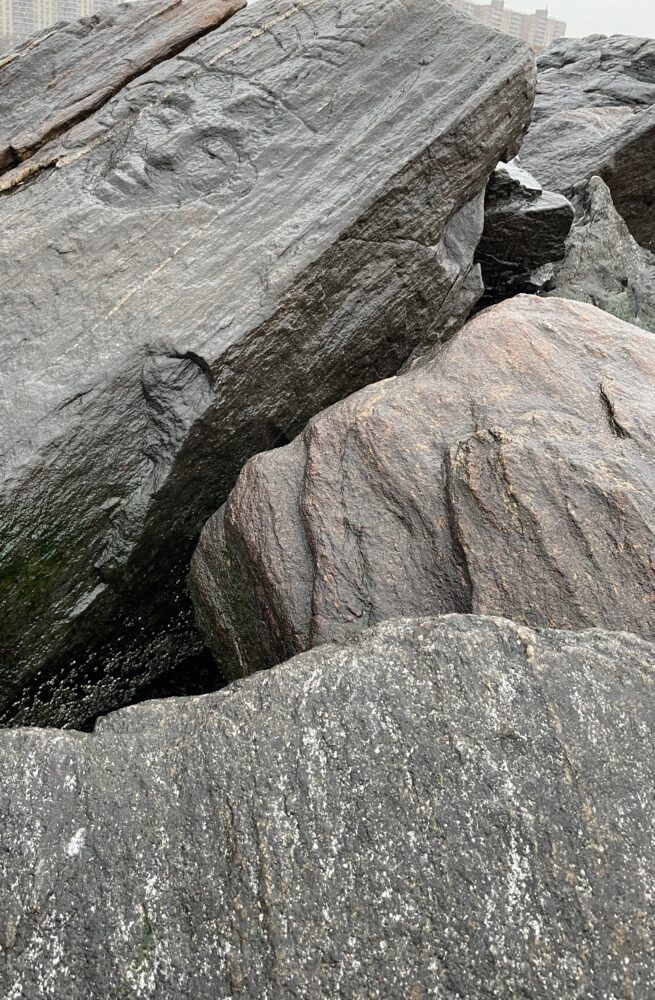It was a cold and rainy day in February the first time I clomped down the deserted wooden boardwalk of Brighton Beach, across the sand, and toward the ocean. As I approached the breakwaters that jut out from this stretch of beach, waves lashed the black rocks, laced with green algae and seaweed. A crooked blue NYC Parks Department sign read “Keep Off Jetty.” There were hardly any footprints but my own, alongside the trident-like tracks of seagulls.

Back in the 1970s, an amateur artist and local resident named John Philip Capello, along with his brother Luciano and a few friends, had clambered over this same breakwater, chisels and hammers in hand, and carved haunting, whimsical faces into the rocks. The sculpted faces are still visible half a century years later, only at the lowest tide (at waxing or waning quarter moon), or after a storm has rearranged the sand, and only to those who know where to look (the location is a secret). You might not notice them unless you’ve been told they are there, but once you spot one face, you see another… and another. I don’t know how many there are; I glimpsed about fourteen.

I learned more about Capello from a fascinating and extensive oral history by Tricia Vita of the Coney Island History Project, the triumphant result of a dozen years spent tracking down the artist behind the carvings, with the help of her friends Bruce Handy and Jim McDonnell, who are Coney Island photographers. (Tricia is the CIHP’s administrative director and manager of its oral history archive.) A self-described “war baby,” born in 1939 into a Sicilian American family in Bensonhurst, Capello tells Tricia he had no formal art training. His first sculptures were made of window glazing putty, and he worked as a handyman and housepainter while supporting his children as a bachelor father. Luciano, his elder brother by about fourteen years, “was the only teacher I had… He taught me that I would learn because I was attentive.”

The face above was the one I noticed first; it is perhaps the most visible. Capello gives Luciano credit for this solemn, bearded figure (“It was not a one-day affair, let me tell you that!”), modeled after the Roman god Neptune, dubbed “Jesus of Brighton” by the photographers Bruce and Jim. Someone has placed a plastic figurine in an adjacent nook, a girl emerging from a cave with wide and wary eyes.

In his archetypal Brooklyn accent, Capello explains that the rock that forms these jetties is Manhattan schist (which he pronounces “schlitz,” like the midcentury beer). “The [rocks] on the beach are not carving stone,” he says. “It’s schlitz, the bedrock of Manhattan…. When they build a skyscraper, they’ve gotta move that stone. So that stone was used for all the jetties because they had to move it, they had to get rid of it…. You can tell that this particular stone comes from Manhattan. It has all those sparkles in it.”

The sparkles of Manhattan skyscrapers seem a world away from the howling, rain-slicked faces rising from the sand on this desolate stretch of beach. One rock has faces carved into it on several sides, and some are mere suggestions of faces—perhaps worn away by the ocean—so that if you look away and back again, you might think you imagined them. Back in the day, no one stopped him and his crew from carving: “It was an artistic community. Creativity was encouraged. It was the seventies,” he says with a laugh. (He also notes that, years later, when he tried carving some boulders beneath a bridge in his current hometown of Sag Harbor, he was scolded for defacing public property.) He and his crew took breaks by playing chess and sketching on the beach; Capello’s children sometimes romped nearby in the sand. He says he isn’t sure how long it took to complete all the faces: “Weeks? Months? Years? Time passes quickly when you’re doing something you enjoy.” But he confesses that he now has carpal tunnel in his left hand: “Because it was such hard stone, anything we could do to blast away into that stone, we did, believe me.”

I returned to Brighton Beach the next day at sunset to see how the light and shadows would play differently over the rocks. This time there were other visitors, including a woman crouching near the jetty with a camera. At first I thought she was a fellow admirer of the faces, but as I got closer I realized she was taking photographs of shells and beach detritus. The sharp rays of the setting sun revealed new faces, like this one with a bulbous nose and puffed cheecks.

Cappello recalls, “We looked into the stones and of course we saw what we wanted to see: a nose, an eye socket, a place to put a mouth or a chin. We’d just take away the stone that didn’t belong.” The group worked with three types of chisels: flat, pointed, and one with teeth, chipping, flaking, pulverizing, and scraping the rock. The face below on the left, with its fan-shaped crown (or hairdo), resembles a sun god.

The goofy face to its right is what I imagine Capello must be referring to when he describes a carved mouth swallowing sand and water with the rising tide, then spitting it out. Sometimes he and his friends would even place a cigarette in the hole. He says their vision for the sculptures often started with a natural protuberance or cleft in the rock. “For me, all sculptures start with the nose. Why? Because it’s the highest point on the face. You have to go from the biggest point back. I can’t add anything; I have to take away…. You won’t see any ears on these stones. If you find one, let me know,” he says with a chuckle. “We didn’t want to be bothered by them—they were the hardest thing to do.”
Some of the carvings are hardly recognizable as faces and appear more like gnarled sea creatures. Ignoring the sign, I crawl over the rocks, trying to view them from new angles.
Mussels, barnacles, seaweed, and gull guano make their own, more ephemeral art.
I notice a woman standing near the jetty, her bike propped against the rocks, as I imagine Capello’s might once have been. She gazes out at the lapping waves, taking deliberate steps toward the water’s edge, as if making her own marks, the setting sun blazing to the west.

I leave my mark in the form of an elongated shadow, stretched to an absurd height across the rocks, perhaps obscuring or haunting a face I have yet to discover.

Many thanks to Tricia Vita, Bruce Handy, Jim McDonnell, and Charles Denson.






 Sense & the City is a monthly blog exploring the hidden corners of New York City. Each month’s post is devoted to one of the five senses. Receive daily sensory impressions via Instagram @senseandthecity.
Sense & the City is a monthly blog exploring the hidden corners of New York City. Each month’s post is devoted to one of the five senses. Receive daily sensory impressions via Instagram @senseandthecity.


8 thoughts on “SIGHT: Brighton Beach’s stone faces”
Caitlin, I look forward every month to your column. This month’s about the hidden Brighton Beach sculptures is my absolute all-time favorite. As always, your writing is exquisite; so imaginative. Takes me right to the ocean side. I am an ocean lover and live in New England. The story of the bachelor father and his children persistently chiseling into rocks covered much of the time by seawater is not only endearing, but an ingenious tale. I know that Italy was united as a country less than years ago, but these natural artists from Brooklyn are demonstrating the artistic passion & talents of true sons of Michelangelo. Not in the gallery, but literally in the sea. True grit!!! Thank you!
Thank you so much! I am glad you enjoyed it. It is a great New York City tale. Definitely worth listening to the full interview: https://www.coneyislandhistory.org/oral-history-archive/john-philip-capello
Fascinating post, as always. One note: the rock is schist, not schitz. Schlitz is a delightful mispronunciation.
Thank you! Corrected.
Awesome piece! My favorite, they’re all my favorite, but this one is really something else. It’s a great human story of these gifted sculptors, from the land of Michelangelo, one of whom is a single dad on top of it all! I love the ocean, so this entry struck multiple chords for me. Your language Caitlin is exquisite; it takes me right there on the shore, sloshing in the surf, searching for those hidden faces carved into stone. Your lessons at the quarry were impressive. Thank you!
Thank you, Sharon! It is a nice local follow-up to the quarry trip, and of course Michelango is an inspiration to all. He references him in the fully interview at the Coney Island History Project.
Beautiful, Caitlin. I love this piece and the artists’ work. I plan to make a trip to see them when the weather gets better.
Amanda
Thanks, Amanda. I wish you luck in finding them!